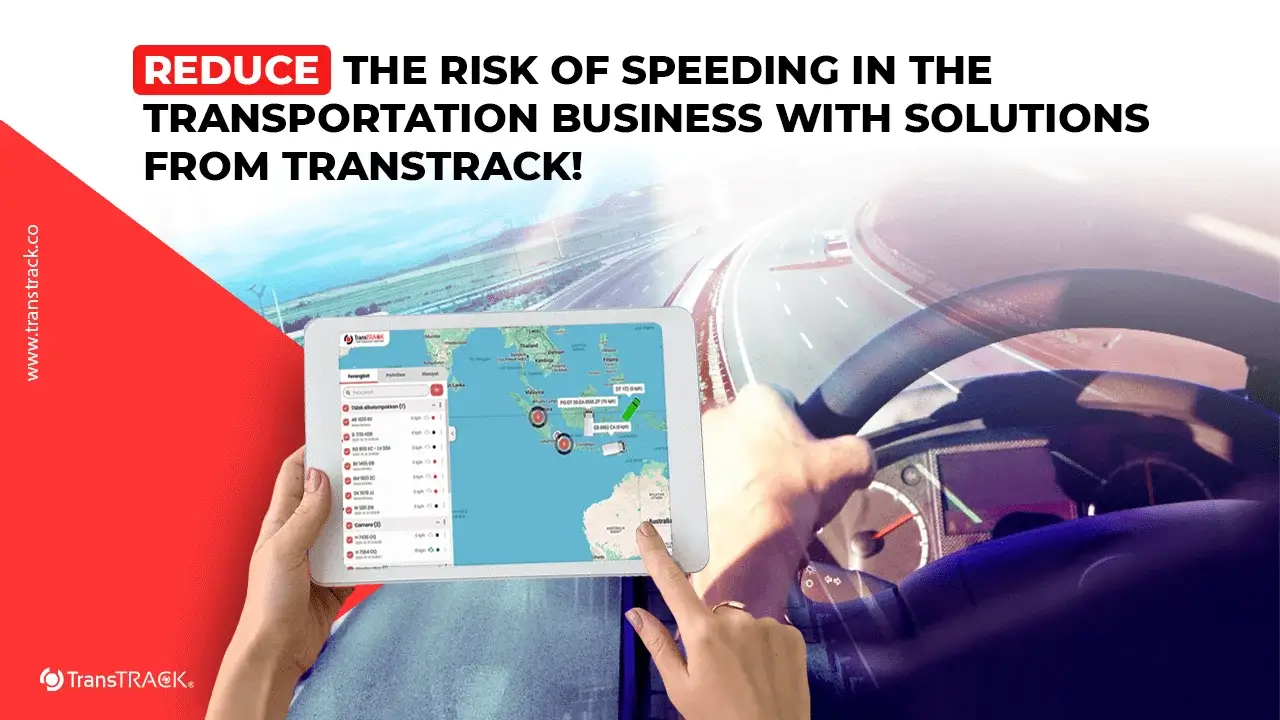Reduce the Risk of Speeding in the Transportation Business with Solutions from TransTRACK!
Posted on October 21, 2025 by Nur Wachda Mihmidati

In the fast-paced world of transportation and logistics, speeding, or driving above the speed limit, is often seen as a way to meet deadlines. However, behind this apparent efficiency, speeding is actually a major cause of increased road accident risk and business losses. This practice not only jeopardizes driver safety but also impacts operational costs, fleet efficiency, and even company reputation.
This TransTRACK article will take an in-depth look at what speeding is, why this behavior is harmful to businesses, and how technology and management solutions can help companies address it effectively.
What is Speeding?
Speeding is the act of driving at a speed exceeding the posted speed limit on the road. While seemingly trivial, speeding is a serious traffic violation that can pose a significant risk to the safety of drivers and other road users. In the context of the transportation and logistics business, speeding impacts not only safety but also operational efficiency and company image.
Speeding often occurs due to time pressure, poor driver habits, or a lack of oversight. To better understand the risks, it’s important to understand how speeding is a leading cause of road accidents and its impact on businesses.
Why Speeding Is One of the Main Causes of Road Accidents
Speeding shortens a driver’s reaction time and increases braking distance. When a vehicle is traveling too fast, the potential for loss of control increases, especially on sharp turns or slippery road conditions. Data from various safety agencies shows that the majority of fatal road accidents involve speeding.
Furthermore, speeding magnifies the impact of a collision because kinetic energy increases with speed. This significantly increases vehicle damage and fatality rates. In a business context, accidents caused by speeding also result in distribution disruptions and financial losses.
Impact of Speeding on Business Operations
Speeding not only threatens safety but also negatively impacts business operations. From increased maintenance costs to reputational damage, undisciplined driving can result. Here are some key impacts companies should be aware of:
Increased Risk of Workplace Accidents
Speeding increases the potential for workplace accidents. Drivers who habitually drive beyond safe limits are more susceptible to accidents, which can impact the safety of themselves, property, and third parties.
Vehicle Maintenance Costs Increase Due to Engine and Brake Stress
Vehicles frequently used for speeding tend to experience faster performance degradation. The engine and braking system work harder, leading to significantly higher service costs.
Higher Fuel Production
Speeding drastically increases fuel consumption. Higher speeds require more energy, resulting in decreased fuel efficiency.
Loss of Company Reputation Due to Traffic Violations
Companies whose fleets frequently engage in speeding can lose the trust of clients and the public. A record of traffic violations can tarnish a brand’s reputation and diminish its credibility in the public eye.
Reasons Fleet Drivers Speed
Speeding in the transportation industry is often not just an individual decision, but rather the result of systemic pressures and operational culture. The following factors are the main reasons why drivers still tend to speed:
Delivery Time Pressure
The demands of fast deliveries often push drivers to exceed speed limits. Tight time limits, without considering road conditions, are a major trigger for speeding.
Lack of Driver Behavior Monitoring System
Without an effective monitoring system, it’s difficult for companies to determine whether drivers are speeding. As a result, violations often occur without firm action.
An Operational Culture Focused on Speed Over Safety
Some companies prioritize delivery speed over driving safety. This mindset fosters a work culture that tolerates speeding to meet targets.
Business Solutions to Overcome Speeding
To mitigate the risks of speeding, companies need to take strategic steps that combine technology, training, and reward systems. Here are some effective solutions that can be implemented:
Implementasi Driver Behaviour Monitoring System (DBMS)
A DBMS helps companies monitor driver behavior in real time. With this system, every speeding incident can be automatically recorded and used as a basis for driver performance evaluation.
Utilization of Fleet Management System with Speed Warning Feature
Modern fleet management systems can provide immediate warnings when speeding occurs. This feature increases driver awareness and the need to maintain safe speeds on every route.
Training and Reward System for Drivers Who Behave Safely
Providing regular training on the dangers of speeding and rewarding disciplined drivers can encourage a stronger safety culture.
Telematics Data Analysis to Monitor Speeding Trends Periodically
Telematics data allows companies to analyze speeding patterns across their fleets. This information is useful for developing more targeted policies and prevention strategies.
Conclusion
Speeding is not only a traffic violation but also a threat to business safety and stability. Its impacts include workplace accidents, increased operational costs, and even damage to a company’s reputation. However, with the implementation of technologies such as DBMS and Fleet Management Systems, along with consistent driver training, the problem of speeding can be effectively addressed.
Optimize security and operational efficiency with TransTRACK’s Fleet Management System. Manage and monitor your fleet in real time and improve the efficiency of speeding issue resolution.

FAQ
Why is speeding a problem in the logistics business?
Speeding increases the risk of accidents, delays in operations due to vehicle breakdowns, and increases maintenance costs. In the logistics industry, this can disrupt the supply chain and erode customer trust.
How can companies monitor driver behavior?
Companies can use monitoring systems such as Driver Behavior Monitoring Systems or Fleet Management Systems to detect speeding and other risky behavior in real-time.
What are the benefits of implementing a speed monitoring system in a fleet?
With a speed monitoring system, companies can identify speeding violations more quickly, provide appropriate training, and reduce overall operational costs.
Can the fleet telematics system provide automatic warnings for speeding?
Yes. Modern fleet telematics systems can send immediate alerts to drivers and fleet managers when speeding is detected, helping prevent accidents and improving driving safety.
Recent Post
Topic :
 Bahasa Indonesia
Bahasa Indonesia









